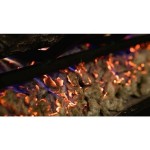Craftsman Style Fireplace Mantel Plans: A Comprehensive Guide
The Craftsman style, also referred to as the American Arts and Crafts movement, emerged in the late 19th and early 20th centuries as a reaction against the ornate excesses of the Victorian era. It champions simplicity, functionality, and natural materials. Fireplace mantels designed in this style reflect these core tenets, emphasizing clean lines, robust construction, and the beauty of exposed wood grain. This article will explore the defining characteristics of Craftsman style fireplace mantels and provide insights into accessing and utilizing plans for their construction.
Craftsman architecture and design philosophy emphasizes the inherent beauty of the materials used. Unlike styles that rely on elaborate ornamentation to mask the materials, Craftsman designs celebrate them. The focus is on highlighting the quality of the wood, the craftsmanship of the joinery, and the overall durability of the structure. This emphasis on authenticity and honesty is a cornerstone of the style.
A Craftsman fireplace mantel serves as a focal point within a room, integrating seamlessly with the surrounding architecture. It provides a visual anchor and contributes to the overall warmth and character of the space. A well-designed mantel enhances the fireplace's functionality by providing a surface for displaying decorative objects and creating a cozy atmosphere.
Key Characteristics of Craftsman Fireplace Mantels
Understanding the defining characteristics of a Craftsman fireplace mantel is crucial before seeking out or developing plans for its construction. These features contribute to the mantel's aesthetic appeal and its ability to harmonize with the overall Craftsman style of a home.
One prominent characteristic is the use of natural materials, primarily wood. Oak, maple, cherry, and fir are common choices, selected for their durability and attractive grain patterns. The wood is often stained rather than painted to allow the natural beauty of the grain to shine through. The stain typically has a warm, rich tone that complements the natural colors of the wood.
Simplicity in design is another defining feature. Craftsman mantels avoid elaborate carvings and excessive ornamentation. Instead, they rely on clean lines, geometric shapes, and well-proportioned components to achieve visual appeal. The focus is on the overall form and the quality of the craftsmanship rather than on intricate details.
Exposed joinery is another hallmark of the Craftsman style. Instead of concealing the joints between different pieces of wood, the design may incorporate visible joinery techniques like mortise and tenon joints, dovetail joints, or finger joints. This not only adds to the structural integrity of the mantel but also showcases the skill of the craftsman.
Substantial brackets and corbels often adorn the sides of a Craftsman mantel, providing visual support and adding to the overall sense of robustness. These brackets are typically simple in design, mirroring the clean lines and geometric shapes of the mantel itself. They may feature subtle curves or chamfered edges, but they generally avoid elaborate carvings.
Finally, a horizontal shelf or mantelpiece is a standard feature, providing a surface for displaying decorative items such as photographs, vases, or artwork. The shelf is typically substantial in size and proportioned to balance with the overall design of the mantel. The edge of the shelf may be beveled or rounded for aesthetic appeal and safety.
Finding and Evaluating Craftsman Fireplace Mantel Plans
Numerous resources offer Craftsman fireplace mantel plans, ranging from free online plans to professionally drafted blueprints. The selection process depends on your skill level, available tools, and the desired level of complexity.
Online searches can yield a variety of free plans. Websites dedicated to woodworking and DIY projects often feature user-submitted plans for Craftsman mantels. While these plans can be a cost-effective option, it is crucial to carefully evaluate their accuracy and completeness. Look for plans that include detailed diagrams, material lists, and step-by-step instructions. Check for user reviews or comments to identify any potential issues or inaccuracies. It is generally advisable to choose plans from reputable sources or those that have been positively reviewed by other woodworkers.
Paid plans are often more detailed and professionally drafted, offering greater accuracy and clarity. These plans may include features such as multiple views, exploded diagrams, and detailed cut lists. Purchasing plans from reputable woodworking magazines, books, or online retailers can provide a higher level of confidence in the quality and accuracy. These plans often undergo a thorough review process to ensure that they are structurally sound and easy to follow. The cost of paid plans can vary depending on the complexity of the design and the level of detail included.
When evaluating any plan, consider your skill level and experience. Choose a plan that matches your capabilities and the tools you have available. A complex design with intricate joinery may be challenging for a beginner, while a simple design may not be satisfying for an experienced woodworker. Consider the size and dimensions of the mantel and ensure that it is appropriate for the size and proportions of the fireplace and the room. Verify that the plan includes accurate measurements and that the dimensions are clearly marked. It is also important to check for any potential safety hazards or structural weaknesses in the design.
Before starting the project, carefully review the material list and ensure that you have access to all of the necessary materials. Choose high-quality lumber that is free from knots, warps, or other defects. Consider the type of wood and its suitability for the intended use. Oak, maple, cherry, and fir are all good choices for Craftsman mantels, depending on your budget and aesthetic preferences. Purchase extra material to account for any mistakes or wastage during the construction process. Consider the cost of finishing materials such as stain, sealant, and hardware when budgeting for the project.
Modifying and Customizing Craftsman Fireplace Mantel Plans
While following a pre-existing plan can provide a solid foundation, it is often desirable to modify or customize the design to better suit your individual needs and preferences. Customization allows you to create a mantel that is unique and perfectly integrated with your home's architecture and décor.
Altering the dimensions of a mantel is a common modification. You may need to adjust the height, width, or depth of the mantel to fit the specific size and shape of your fireplace opening. Ensure that any dimensional changes maintain the overall proportions and balance of the design. Scaling the entire plan proportionally can help to preserve the aesthetic integrity of the mantel while accommodating different size requirements. Consider the impact of dimensional changes on the structural integrity of the mantel and make adjustments as needed to ensure that it remains stable and secure.
Changing the type of wood used is another popular customization option. Different types of wood have different colors, grain patterns, and textures, which can significantly impact the appearance of the mantel. Consider the overall color scheme of your room and choose a wood that complements the existing décor. Oak and maple are good choices for a light, airy look, while cherry and walnut offer a richer, more traditional aesthetic. Be aware that some types of wood are more difficult to work with than others, so choose a material that is appropriate for your skill level.
Adjusting the details of the joinery can also customize the mantel. While exposed joinery is a characteristic feature of Craftsman style, the specific type of joint used can be varied. Experiment with different types of joints, such as mortise and tenon, dovetail, or finger joints, to create a unique look. Consider the visual impact of each type of joint and choose one that complements the overall design of the mantel. Ensure that the chosen joint is structurally sound and capable of withstanding the weight and stress of the mantel components.
Adding or modifying decorative elements can enhance the visual appeal of the mantel. Consider adding simple carvings, chamfered edges, or decorative inlays to add visual interest without compromising the clean lines and simplicity of the Craftsman style. Be mindful of the scale and proportion of any decorative elements and ensure that they are in harmony with the overall design of the mantel. Avoid excessive ornamentation or overly elaborate details, as these can detract from the simplicity and elegance of the Craftsman style.
Finally, consider the finish of the mantel. Stain is the most common finish for Craftsman mantels, but the specific color and type of stain can be customized to suit your preferences. Choose a stain that highlights the natural beauty of the wood grain and complements the overall color scheme of your room. Experiment with different stain colors and application techniques to achieve the desired look. Consider applying a clear sealant or topcoat to protect the finish and enhance its durability. Be sure to follow the manufacturer's instructions carefully when applying stain and sealant.

The Craftsman Fireplace A Standout Fire Space

Home Improvement Build Your Own Fireplace Mantel Hearth Craftsman Style Make It Love

How To Build A Craftsman Style Fireplace Mantel Fine Homebuilding Designs

How To Build A Shaker Fireplace Mantel And Surround Woodworking Diy Project Plans You Can Make It

White Craftsman Mantel And Shiplap Wall Makeover Her Tool Belt

Craftsman Style Fireplace Mission Mantel Plans Mantels

White Craftsman Mantel And Shiplap Wall Makeover Her Tool Belt

Home Improvement Build Your Own Fireplace Mantel Hearth Craftsman Style Make It Love

Craftsman Style Mantel Bookcases Thisiscarpentry
Mantels Surrounds Mitre Contracting Inc
Related Posts








